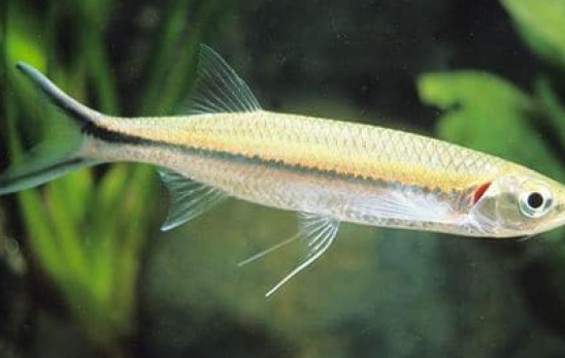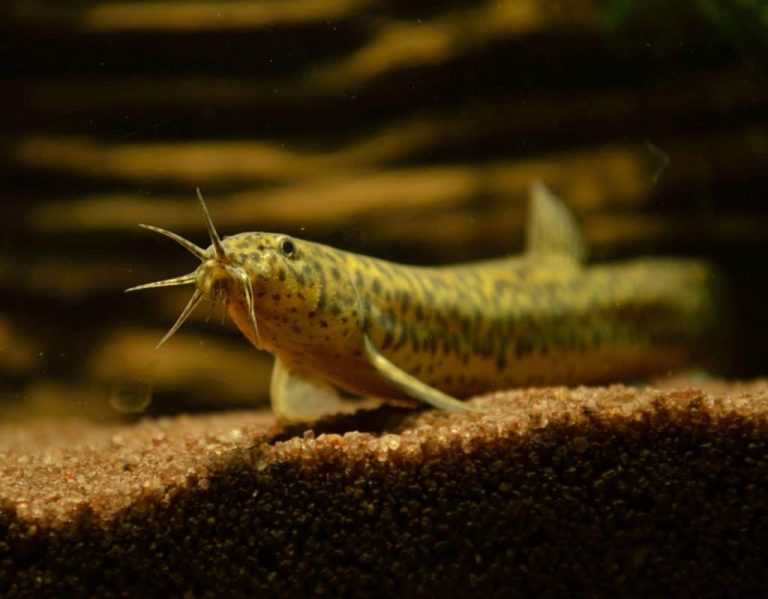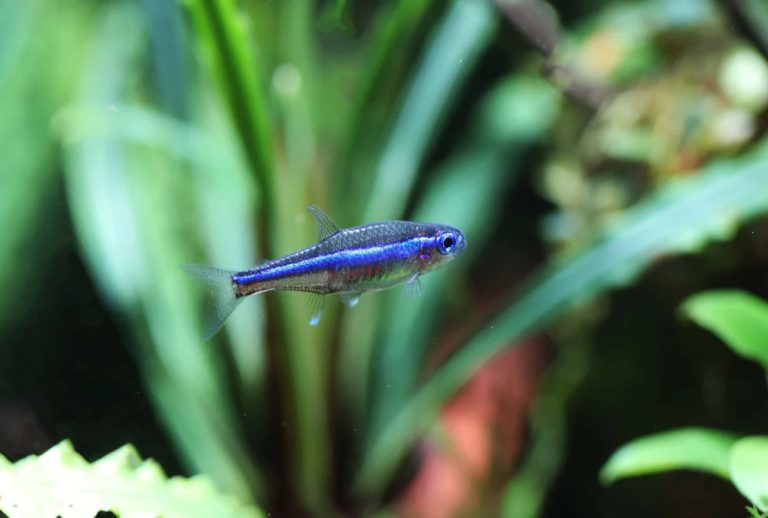Silver Apollo Shark
Silver Apollo Shark (Luciosoma setigerum) is a lesser-known freshwater fish in the aquarium hobby. They’re often mistaken for the more common Bala Shark, but the Silver Apollo Shark is much smaller and possesses unique silver-blue tones. If you’re looking to care for Silver Apollo Sharks, here’s a basic guide:
Silver Apollo Shark Species Summary:
| Scientific Name: | Luciosoma setigerum |
| Origin: | Freshwater sources of Southeast Asia. |
| Diet: | Omnivore (consumes a mixture of plant-based food and small aquatic animals). |
| Behavior: | Active and can be a bit shy. |
| Behavior Towards Their Own Species: | They can be slightly aggressive or territorial with smaller or similarly shaped fish. |
| Swimming Zone: | Mid to upper water columns. |
| Water Temperature: | 22 – 26 °C |
| Water Hardness: | 5 – 12 GH |
| pH Level: | 6.0 – 7.5 |
| Minimum Aquarium Volume: | At least 280 Liters for a school. |
| Adult Size: | Typically around 10 cm. |
| Reproduction: | Not commonly bred in captivity; details of their breeding habits in the wild are not widely documented. |
| Lifespan: | Up to 5 years with proper care, though specifics can vary. |
| Care: | Moderate. They require ample space for swimming and good water quality. |
Tank Size and Setup
- Tank Size: For the Silver Apollo Shark, a spacious tank is essential. A minimum of 75 gallons is often suggested, but if you’re housing a school or have other fish species, you might consider going larger. Their active swimming nature necessitates plenty of room to maneuver, dart, and explore.
- Decor: These fish, while active, can sometimes display a timid nature. Hence, creating a habitat with ample hiding spots becomes crucial for their well-being. Incorporating pieces of driftwood, intricately designed rocks, and densely planted areas can help them feel secure and less stressed. Plants like Java Fern, Anubias, and tall stem plants can be ideal. However, it’s essential to strike a balance; while they require these hiding spots, the Silver Apollo Shark is known for its love of open swimming areas. Thus, ensure that a significant portion of the tank remains uncluttered, allowing them free rein to swim and display their natural behaviors.
- Substrate: A substrate plays multiple roles in an aquarium — from aesthetics to influencing the water chemistry. For the Silver Apollo Shark, a fine-grained, soft substrate is best. This can be in the form of sand or finely milled gravel. Such a substrate not only mirrors their natural habitat but also ensures their delicate undersides are not harmed when they explore the bottom.
- Water Flow: The natural habitats of the Silver Apollo Shark are flowing rivers and streams. To replicate this environment, aim for moderate water flow in the tank. This can be achieved through a suitably powerful filter or a supplementary powerhead. The consistent flow not only offers them a semblance of their wild environment but also aids in maintaining better water quality by ensuring effective circulation.
Water Parameters

- Temperature (72°F – 79°F or 22°C – 26°C):
- Maintaining the right temperature is fundamental for the health of any aquarium fish. For the Silver Apollo Shark, this temperature range closely mirrors the tropical freshwater systems they hail from. A consistent and stable temperature within this range promotes regular metabolism, good immune function, and overall well-being. It’s prudent to invest in a reliable heater and, more importantly, a separate thermometer to monitor the tank’s temperature. Sudden or drastic temperature changes can be detrimental and stress-inducing for these fish, so ensure any adjustments are made gradually.
- pH (6.0 – 7.5):
- The pH level in an aquarium represents how acidic or alkaline the water is. The Silver Apollo Shark thrives in water that is slightly acidic to slightly alkaline. A pH of 6.0 to 7.5 is most conducive to their health. It’s noteworthy that rapid fluctuations in pH can be very harmful, so stability is key. Regularly testing the water and taking corrective measures, if the pH strays from this range, is crucial. There are commercial products and natural remedies available to adjust pH levels in aquariums.
- Hardness (5 – 12 dGH):
- Water hardness refers to the concentration of calcium and magnesium ions present. The Silver Apollo Shark prefers water that is soft to moderately hard. A range of 5-12 degrees General Hardness (dGH) is considered ideal for these fish. While they might tolerate slight deviations from this range, it’s best to strive for these optimal levels. If you live in an area with particularly hard or soft water, consider using water conditioners or mixes to achieve the desired hardness.
Feeding
- Diet:
- Omnivorous Nature: Silver Apollo Sharks have an omnivorous diet, meaning they derive their nutrients from both plant and animal sources. This dietary flexibility allows them to thrive in a variety of conditions and makes feeding them a more enjoyable experience for the aquarium keeper.
- Variety is Key: While they can survive on a staple diet of high-quality flakes or pellets, introducing a variety of foods not only meets their nutritional needs but also keeps them stimulated and interested in feeding times. Flakes and pellets can be a base diet, ensuring they get a balanced mix of essential nutrients.
- Frozen Foods: Periodic feedings of frozen foods like brine shrimp and daphnia introduce proteins and fats that might not be present in sufficient amounts in flake or pellet foods. These offerings closely resemble the small invertebrates they might consume in the wild.
- Vegetable Matter: Incorporating blanched vegetables such as zucchini, spinach, or peas can provide necessary fiber and other nutrients. It’s a good practice to observe their reaction to different vegetables; some might be more favored than others.
- Feeding Frequency:
- Consistency: Regular feeding times help establish a routine, making the fish less stressed and more active during feeding. Once or twice a day is generally recommended.
- Portion Control: Overfeeding is a common issue in aquariums. It can lead to water quality problems and health concerns for the fish. It’s essential to monitor the quantity of food provided and ensure that the fish are consuming all of it within a few minutes. If food remains after this time, it’s an indication to reduce the portion size during the next feeding.
- Observation: Each aquarium and its inhabitants can have unique feeding behaviors. Regularly observing the Silver Apollo Shark during feeding times will allow adjustments to be made for portion sizes and the types of food offered.
Tankmates

- Compatibility:
- Aggressiveness: The Silver Apollo Shark, while stunning and active, has a somewhat assertive nature, especially towards smaller or fish of similar shape. Their territorial tendencies can cause unwanted stress to less dominant tankmates. Hence, choosing the right companions is paramount to prevent confrontations.
- Larger, Peaceful Tankmates: These sharks will fare better in a community with larger, non-aggressive fish. Some of the species that have shown compatibility include:
- Larger Tetras: Species like Congo Tetras or Bleeding Heart Tetras. They’re vibrant, active, and can stand their ground without being aggressive.
- Barbs: Fish like Tinfoil Barbs or Golden Barbs. They’re robust and less likely to be bullied.
- Danios: Bigger species like Giant Danios can be an excellent fit due to their swift swimming nature.
- Loaches: Fish like Clown Loaches or YoYo Loaches can be considered, as they mostly occupy the bottom regions and are peaceful.
- Schooling Nature:
- Natural Behavior: In the wild, Silver Apollo Sharks are often seen in groups, showcasing schooling behavior. This behavior is an evolutionary strategy, often used for protection against predators or for efficient hunting.
- Stress Reduction: In a home aquarium, maintaining them in a group can help in diffusing aggression and territorial tendencies among themselves. It also offers them a sense of security, which can be seen in their active swimming patterns.
- Ideal Group Size: A group of at least 5-6 is ideal. This number ensures they have enough of their kind to interact with, reducing chances of stress, bullying, or territorial disputes.
Behavior
- Active Swimmers:
- Youthful Energy: In their juvenile stage, Silver Apollo Sharks exhibit a particularly high level of activity. This exuberance can be captivating to watch, as they dart around exploring every nook and cranny of their environment. Their swift and agile swimming patterns are reminiscent of their life in flowing water habitats where they’d constantly be on the move.
- Adequate Space Requirement: Given their active nature, it’s vital that they’re housed in a tank spacious enough to cater to their swimming needs. Restricting them to a confined space can be stressful and may hamper their natural behavior.
- Timidity:
- Adjustment Period: When introduced to a new tank or environment, it’s not uncommon for the Silver Apollo Shark to display signs of shyness or reticence. The experience can be overwhelming, with unfamiliar surroundings, water parameters, and tankmates.
- Providing Comfort: It’s beneficial to create an environment with multiple hiding spots using decor like rocks, driftwood, and plants. These hiding spots offer them a retreat and make the adjustment process smoother.
- Patience is Key: Over time, with a consistent routine and stable water parameters, they’ll begin to feel more secure and start to venture out more frequently. Observing their behavior and ensuring they’re not being bullied by other tankmates is crucial during this phase.
- Territoriality with Age:
- Mature Dominance: As Silver Apollo Sharks mature, they can develop more assertive behaviors. This territoriality might manifest in chasing off similarly shaped or smaller fish from their “claimed” areas.
- Tank Arrangement: To mitigate aggressive tendencies, ensure there are distinct territories within the tank, created using decor and plants. This arrangement allows each fish to claim a zone, reducing conflicts.
- Schooling Benefits: Keeping them in a school, as mentioned earlier, can help distribute this territorial behavior, ensuring no single fish becomes overly dominant or stressed.
Breeding
- Difficulty in Captivity:
- Rare Occurrences: Breeding Silver Apollo Sharks in a home aquarium setting is quite challenging. There are limited instances of hobbyists reporting successful spawning. This rarity might be attributed to specific, yet not fully understood, environmental cues in their natural habitats that stimulate breeding behaviors.
- Professional Breeding: While difficult for the average hobbyist, there might be more success in specialized breeding facilities with controlled environments and experts overseeing the process.
- Setting the Stage for Breeding:
- Tank Size: A spacious environment is crucial if breeding is to be attempted. A larger tank not only allows for the establishment of territories but also gives the fish a sense of security and space, possibly making them more inclined to exhibit natural breeding behaviors.
- Water Conditions: Just like with other aspects of fish care, pristine water conditions are essential. Regular water changes, proper filtration, and maintaining optimal water parameters can enhance the chances of inducing spawning. Some breeders believe in mimicking rainy season conditions, introducing cooler water during changes to simulate the influx of rainwater in their natural habitats.
- Diet: Providing a nutritious, varied diet can play a role in conditioning the fish for breeding. A protein-rich diet with live or frozen foods can enhance their overall health and potentially stimulate reproductive behaviors.
- Identifying Mates:
- It’s often challenging to distinguish between males and females, given the lack of pronounced sexual dimorphism. However, in many fish species, females might appear plumper or fuller-bodied, especially when carrying eggs.
- Breeding Behavior:
- Should breeding occur, one might observe distinct behaviors like chasing, more pronounced territoriality, or specific spots in the tank being guarded more diligently.
- Post-spawning Care:
- If eggs are laid, it’s crucial to monitor their development. Depending on the behavior of the adults, it might be necessary to separate the eggs or fry to ensure their safety, as some fish might exhibit cannibalistic tendencies.
Maintenance

- Water Change:
- Importance: Weekly water changes are critical to remove waste products, excess food, and any potential toxins that may build up over time. Fresh water also reintroduces essential minerals that might be depleted through the week.
- Frequency & Volume: Aim for a weekly water change of 25-30%. This amount strikes a balance between maintaining water quality and avoiding a drastic change in water parameters, which could stress the fish.
- Procedure: When changing the water, it’s essential to ensure that the temperature of the new water is close to the tank’s existing temperature. Using a water conditioner to neutralize chlorine and other potential toxins in tap water is vital.
- Filtration:
- Significance: Silver Apollo Sharks, like many other fish, produce waste that can degrade water quality over time. A good filtration system is not just about cleanliness—it’s about creating a sustainable environment where beneficial bacteria break down this waste into less harmful substances.
- Type of Filter: A canister or hang-on-back filter with a good flow rate is typically suitable for tanks housing Silver Apollo Sharks. The filter should be capable of mechanical, chemical, and biological filtration.
- Mechanical Filtration: This captures physical particles, such as detritus or uneaten food.
- Chemical Filtration: Using activated carbon or other resins, this removes odors, discolorations, and certain chemicals.
- Biological Filtration: Beneficial bacteria reside here, converting toxic ammonia and nitrite into less harmful nitrate.
- Maintenance: Filters should be checked and cleaned regularly. However, avoid cleaning all parts of the filter simultaneously, as this could disrupt the beneficial bacteria colonies. Instead, stagger the cleaning to ensure a continuous population of these bacteria.
- Additional Maintenance Tips:
- Substrate Cleaning: Using a gravel vacuum during water changes can help remove waste trapped in the substrate, especially if it’s a fine-grained substrate.
- Tank Decor: Periodically check and clean decorations and hiding spots to prevent algae buildup or trapped detritus.
- Equipment Check: Regularly inspect heaters, filters, and other equipment for signs of wear or malfunction to prevent any potential mishaps.
Potential Issues
- Health Concerns:
- Common Diseases:
- Ich (White Spot Disease): Caused by a parasite, ich presents as small white spots on the fish’s skin. Fish with ich may scratch against objects and show respiratory distress. Treatment often involves raising the water temperature and using anti-parasitic medications.
- Fungal Infections: Manifest as white or grayish cotton-like growths on the fish. They often occur when fish are injured or stressed. Antifungal treatments can be effective in managing this.
- External Parasites: These include flukes and anchor worms. Infected fish may scratch against surfaces or display redness and inflammation. Anti-parasitic treatments and improving water quality can address this issue.
- Preventive Measures:
- Quarantine: Any new fish or plants should be quarantined for at least 2-4 weeks before introducing them to the main tank. This helps in identifying and treating any potential disease carriers.
- Regular Observation: Monitor fish behavior and appearance regularly. Early detection of anomalies can lead to quicker interventions and better outcomes.
- Common Diseases:
- Jumping Behavior:
- Why They Jump: The Silver Apollo Shark, like many other fish, might jump due to various reasons such as perceived threats, aggression from other fish, or suboptimal water conditions.
- Tank Lid: A tight-fitting lid is paramount. It not only prevents escape but also reduces the risk of injury. Ensure that the lid allows for sufficient gas exchange and doesn’t trap excessive humidity.
- Tank Setup Adjustments: Minimizing stressors can reduce the desire to jump. This includes providing adequate hiding spots, maintaining water quality, and ensuring compatibility with tankmates.
- Additional Considerations:
- Overcrowding: Too many fish or inadequate space can lead to elevated stress and aggression, which can prompt jumping or other erratic behaviors. Ensure the tank size meets the requirements of all its inhabitants.
- Nutrition: A balanced diet can boost the immune system and overall health of the fish, making them less susceptible to diseases.
- Water Quality: Consistent water parameters and cleanliness reduce the risk of many common aquarium ailments. Regular testing for ammonia, nitrite, nitrate, and pH can help in maintaining a conducive environment.
Silver Apollo Sharks are beautiful and unique additions to larger freshwater tanks. Their shimmering appearance and active swimming behaviors can bring life to any aquarium. However, they do require some care in terms of tank size, water quality, and tankmates. Proper research and preparation are key to giving them a healthy and happy life in captivity.






